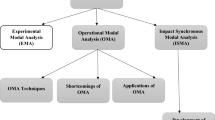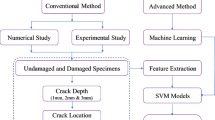Abstract
In response to the identification problem concerning multi-degree of freedom (MDOF) nonlinear systems, this study presents the extended forward orthogonal regression (EFOR) based on predicted residual sums of squares (PRESS) to construct a nonlinear dynamic parametrical model. The proposed parametrical model is based on the non-linear autoregressive with exogenous inputs (NARX) model and aims to explicitly reveal the physical design parameters of the system. The PRESS-based EFOR algorithm is proposed to identify such a model for MDOF systems. By using the algorithm, we built a common-structured model based on the fundamental concept of evaluating its generalization capability through cross-validation. The resulting model aims to prevent over-fitting with poor generalization performance caused by the average error reduction ratio (AERR)-based EFOR algorithm. Then, a functional relationship is established between the coefficients of the terms and the design parameters of the unified model. Moreover, a 5-DOF nonlinear system is taken as a case to illustrate the modeling of the proposed algorithm. Finally, a dynamic parametrical model of a cantilever beam is constructed from experimental data. Results indicate that the dynamic parametrical model of nonlinear systems, which depends on the PRESS-based EFOR, can accurately predict the output response, thus providing a theoretical basis for the optimal design of modeling methods for MDOF nonlinear systems.
Similar content being viewed by others
References
Billings S A. Nonlinear System Identification: NARMAX Methods in the Time, Frequency, and Spatio-Temporal Domains. Chichester: John Wiley & Sons, 2013
Xia X, Zhou J, Xiao J, et al. A novel identification method of Volterra series in rotor-bearing system for fault diagnosis. Mechanical Systems and Signal Processing, 2016, 66–67: 557–567
Li S, Li Y. Model predictive control of an intensified continuous reactor using a neural network Wiener model. Neurocomputing, 2016, 185: 93–104
Gotmare A, Patidar R, George N V. Nonlinear system identification using a cuckoo search optimized adaptive Hammerstein model. Expert Systems with Applications, 2015, 42(5): 2538–2546
Guo Y, Guo L Z, Billings S A, et al. An iterative orthogonal forward regression algorithm. International Journal of Systems Science, 2015, 46(5): 776–789
De Hoff R L, Rock S M. Development of simplified nonlinear models from multiple linearizations. In: Proceedings of 1978 IEEE Conference on Decision and Control including the 17th Symposium on Adaptive Processes. San Diego: IEEE, 1979, 316–318
Wei H L, Lang Z Q, Billings S A. Constructing an overall dynamical model for a system with changing design parameter properties. International Journal of Modelling, Identification and Control, 2008, 5(2): 93–104
Chen S, Wu Y, Luk B L. Combined genetic algorithm optimization and regularized orthogonal least squares learning for radial basis function networks. IEEE Transactions on Neural Networks, 1999, 10(5): 1239–1243
Orr M J L. Regularization in the selection of radial basis function centers. Neural Computation, 1995, 7(3): 606–623
Kohavi R. A study of cross-validation and bootstrap for accuracy estimation and model selection. In: Proceedings of the 14th International Joint Conference on Artificial Intelligence. Montreal: Morgan Kaufmann Publishers Inc., 1995, 14(2): 1137–1145
Piroddi L. Simulation error minimisation methods for NARX model identification. International Journal of Modelling, Identification and Control, 2008, 3(4): 392–403
Worden K, Manson G, Tomlinson G R. A harmonic probing algorithm for the multi-input Volterra series. Journal of Sound and Vibration, 1997, 201(1): 67–84
Worden K, Tomlinson G R. Nonlinearity in Structural Dynamics: Detection, Identification and Modelling. Boca Raton: CRC Press, 2000
Li P, Wei H L, Billings S A, et al. Nonlinear model identification from multiple data sets using an orthogonal forward search algorithm. Journal of Computational and Nonlinear Dynamics, 2013, 8(4): 041001
Palmqvist S, Zetterberg H, Blennow K, et al. Accuracy of brain amyloid detection in clinical practice using cerebrospinal fluid ß- amyloid 42: A cross-validation study against amyloid positron emission tomography. JAMA Neurology, 2014, 71(10): 1282–1289
Myers R H. Classical and Modern Regression with Applications. Boston: PWS and Kent Publishing Company, 1990
Hong X, Sharkey P M, Warwick K. A robust nonlinear identification algorithm using PRESS statistic and forward regression. IEEE Transactions on Neural Networks, 2003, 14(2): 454–458
Wang L, Cluett W R. Use of PRESS residuals in dynamic system identification. Automatica, 1996, 32(5): 781–784
Hong X, Sharkey P M, Warwick K. Automatic nonlinear predictive model-construction algorithm using forward regression and the PRESS statistic. IEE Proceedings: Control Theory and Applications, 2003, 150(3): 245–254
Zhang Y, Yang Y. Cross-validation for selecting a model selection procedure. Journal of Econometrics, 2015, 187(1): 95–112
Savaresi S M, Bittanti S, Montiglio M. Identification of semiphysical and black-box non-linear models: The case of MR-dampers for vehicles control. Automatica, 2005, 41(1): 113–127
Acknowledgements
This work was supported by the National Science Foundation of China (Grant No. 11572082), the Excellent Talents Support Program in Institutions of Higher Learning in Liaoning Province, China (Grant No. LJQ2015038), the Fundamental Research Funds for the Central Universities of China (Grant Nos. N150304004 and N140301001), and the Key Laboratory for Precision and Non-traditional Machining of the Ministry of Education, Dalian University of Technology (Grant No. JMTZ201602).
Author information
Authors and Affiliations
Corresponding author
Rights and permissions
About this article
Cite this article
Liu, H., Zhu, Y., Luo, Z. et al. PRESS-based EFOR algorithm for the dynamic parametrical modeling of nonlinear MDOF systems. Front. Mech. Eng. 13, 390–400 (2018). https://doi.org/10.1007/s11465-017-0459-5
Published:
Issue Date:
DOI: https://doi.org/10.1007/s11465-017-0459-5




